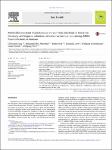Methicillin-resistant Staphylococcus aureus from infections in horses in Germany are frequent colonizers of veterinarians but rare among MRSA from infections in humans
Cuny, Christiane
Abdelbary, Mohamed M. H.
Köck, Robin
Layer, Franziska
Scheidemann, Wolfgang
Werner, Guido
Witte, Wolfgan
A total of 272 methicillin-resistant Staphylococcus aureus (MRSA) from equine infections originating from 17 equine hospitals and 39 veterinary practices in Germany as well as 67 isolates from personnel working at equine clinics were subjected to molecular typing. The majority of isolates from horses was attributed to clonal complex (CC) 398 (82.7%). Within CC398, 66% of isolates belonged to a subpopulation (clade) of CC398, which is associated with equine clinics. MRSA attributed to CC8 (ST254, t009, t036, SCCmecIV; ST8, t064, SCCmecIV) were less frequent (16.5%). Single isolates were attributed to ST1, CC22, ST130, and ST1660. The emergence of MRSA CC22 and ST130 in horses was not reported so far. Nasal MRSA colonization was found in 19.5% of veterinary personnel with occupational exposure to horses. The typing characteristics of these isolates corresponded to isolates from equine infections. Comparing typing characteristics of equine isolates with those of a substantial number of isolates from human infections typed at the German Reference Center for Staphylococci and Enterococci (2006–2014; n = 10864) yielded that the proportion of isolates exhibiting characteristics of MRSA from equine medicine is very low (< 0.5%). As this low proportion was also found among MRSA originating from nasal screenings of human carriers not suffering from a staphylococcal infection (n = 5546) transmission of MRSA from equine clinics to the community seems to be rare so far.
Dateien zu dieser Publikation
Keine Lizenzangabe

